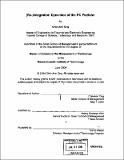| dc.contributor.advisor | Henry Birdseye Weil. | en_US |
| dc.contributor.author | Ong, Chin-Ann, 1972- | en_US |
| dc.contributor.other | Massachusetts Institute of Technology. Management of Technology Program. | en_US |
| dc.date.accessioned | 2005-06-02T18:44:19Z | |
| dc.date.available | 2005-06-02T18:44:19Z | |
| dc.date.copyright | 2004 | en_US |
| dc.date.issued | 2004 | en_US |
| dc.identifier.uri | http://hdl.handle.net/1721.1/17804 | |
| dc.description | Thesis (S.M.M.O.T.)--Massachusetts Institute of Technology, Sloan School of Management, Management of Technology Program, 2004. | en_US |
| dc.description | Includes bibliographical references (leaves 110-112). | en_US |
| dc.description.abstract | Since the 1990's, the PC has come under increasing integration pressure. Many electronic components which had previously existed as separate standalone components have been integrated onto the PC mainboard. Examples include the disk-drive, video, sound and network controllers. Some of these had in fact been de-integrated from the mainboard in the 1980's during the burgeoning years of the PC boom (when the capabilities of on-board electronics could not keep pace with the performance demands) before being re-integrated. Technological and market forces drive this integration trend. These forces are the result of the complex interaction between technological advances, industry competitors (old and new), suppliers, customers, complementors and potential substitutes for the PC. The forces are often inter-dependent and the dynamic system set up by a combination of all these forces produces the integration paths of the aforementioned components. Besides integration trends, the future evolution of the PC is another area of great interest. In particular, the roles played by architectural innovation and digital convergence are significant in determining the future utility of the PC, in terms of both its reach (extent of peripheral device coverage) and range (extent of application). The potential of the PC is currently held in check by the limitations of its existing architecture and the confines of the traditional industry boundaries. The removal of both barriers will perhaps lead to a shift of paradigm to that of a virtual PC, which is dynamically constructed (by the intelligent network computer) from shared resources found on the network. This scenario will usher in an era of universal computing - access to information and processing power anytime, | en_US |
| dc.description.abstract | (cont.) anywhere and through any device - which represent today's concept of computing utopia. | en_US |
| dc.description.statementofresponsibility | by Chin-Ann Ong. | en_US |
| dc.format.extent | 112 leaves | en_US |
| dc.format.extent | 6501457 bytes | |
| dc.format.extent | 6512897 bytes | |
| dc.format.mimetype | application/pdf | |
| dc.format.mimetype | application/pdf | |
| dc.language.iso | eng | en_US |
| dc.publisher | Massachusetts Institute of Technology | en_US |
| dc.rights | M.I.T. theses are protected by copyright. They may be viewed from this source for any purpose, but reproduction or distribution in any format is prohibited without written permission. See provided URL for inquiries about permission. | en_US |
| dc.rights.uri | http://dspace.mit.edu/handle/1721.1/7582 | |
| dc.subject | Management of Technology Program. | en_US |
| dc.title | (Re-)integration dynamics of the PC platform | en_US |
| dc.type | Thesis | en_US |
| dc.description.degree | S.M.M.O.T. | en_US |
| dc.contributor.department | Management of Technology Program. | en_US |
| dc.contributor.department | Sloan School of Management | |
| dc.identifier.oclc | 56551316 | en_US |
